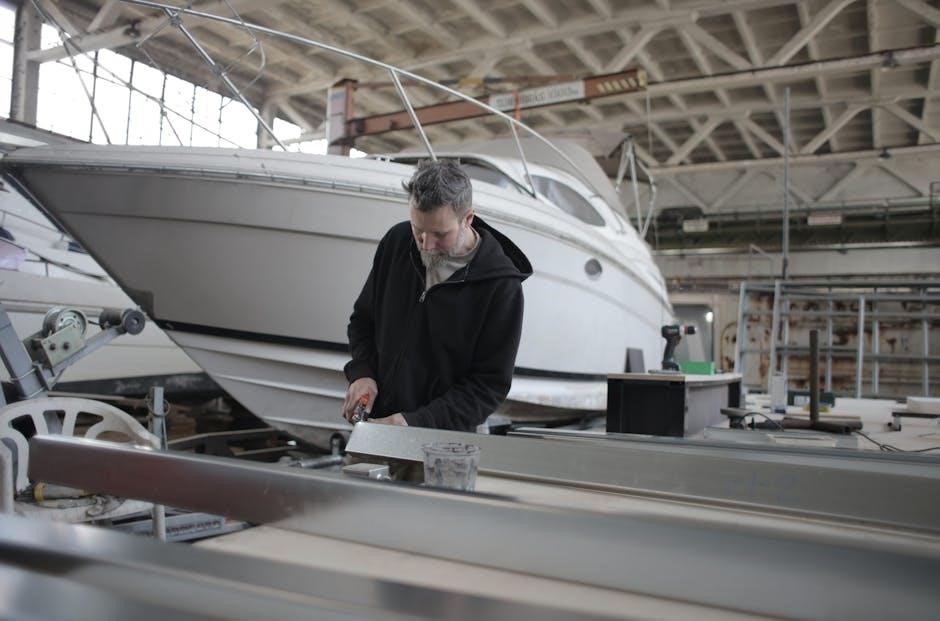
Yamaha boat service manuals are an essential guide for maintaining, troubleshooting, and repairing your vessel, ensuring peak performance and safety for all users with detailed instructions and expert advice.
What is a Yamaha Boat Service Manual?
A Yamaha boat service manual is a comprehensive guide providing detailed instructions for maintenance, troubleshooting, and repairs of Yamaha marine engines and systems. It includes specifications, diagrams, and procedures to ensure proper care and optimal performance of your boat, catering to both DIY enthusiasts and professional technicians.
Key Sections of a Yamaha Boat Service Manual
Yamaha boat service manuals feature sections like maintenance schedules, troubleshooting guides, repair procedures, and parts diagrams. They also include safety precautions, diagnostic tools, and detailed instructions for oil changes, flushing, and engine care, ensuring comprehensive coverage for all aspects of boat upkeep and repair.
Benefits of Using a Yamaha Boat Service Manual
Using a Yamaha boat service manual ensures proper maintenance, enhances safety, and extends the lifespan of your vessel. It provides clear instructions for DIY repairs, saving costs and promoting self-sufficiency. Regular use helps prevent issues, optimizes performance, and ensures compliance with manufacturer guidelines, protecting your investment and improving overall boating experiences.
Where to Find Yamaha Boat Service Manuals
Yamaha boat service manuals are available on the official Yamaha website, Yamaha Marine Parts and Accessories portals, and through authorized Yamaha dealers or third-party forums for convenient access.
Official Yamaha Website and Resources
The official Yamaha website and its dedicated portals, such as YamahaPubs.com, offer direct access to genuine service manuals for Yamaha boats. These resources provide comprehensive guides for maintenance, troubleshooting, and repairs, ensuring accuracy and safety. Manuals can be purchased for download, often with a 30-day access period, making them a reliable choice for boat owners.
Authorized Yamaha Dealers
Authorized Yamaha dealers offer genuine service manuals for Yamaha boats, ensuring authenticity and reliability. These dealers provide expert support, parts, and repair guidance, making them a trusted source for maintaining your vessel. Purchasing manuals through them guarantees compliance with Yamaha standards and provides access to professional advice for optimal boat performance and longevity.
Third-Party Sources and Forums
Third-party sources and forums offer a wealth of resources for Yamaha boat service manuals, including downloadable guides, DIY repair tips, and community discussions. Websites like Yamaha Outboard Forum provide valuable insights and shared experiences from enthusiasts. While these sources can be cost-effective, ensure the information is verified for accuracy and compatibility with your specific model to avoid potential issues.

Maintenance Tips from Yamaha Service Manuals
Yamaha service manuals emphasize regular maintenance checks, oil changes, and flushing systems to ensure optimal boat performance and longevity. Follow these guidelines for a reliable vessel.
Regular Maintenance Checks
Regular maintenance checks are crucial for ensuring your Yamaha boat operates efficiently. Schedule routine inspections of engine components, propellers, and electrical systems. Replace oil and filters every 50 hours, and flush cooling systems regularly. Adhere to Yamaha’s maintenance timelines to prevent wear and tear.
Oil and Filter Changes
Regular oil and filter changes are vital for your Yamaha boat’s engine longevity. Use high-quality marine oil and replace filters every 50 hours of operation. Always follow Yamaha’s recommended oil viscosity and filter specifications to maintain optimal engine performance and prevent damage.
Flushing and Cleaning Procedures
Flushing and cleaning are crucial for maintaining your Yamaha boat’s performance. Regularly flush the engine and cooling system with fresh water to remove salt and debris. Clean the propeller and hull to prevent corrosion and ensure optimal operation. Follow Yamaha’s guidelines to avoid damage and extend the lifespan of your vessel.

Troubleshooting Common Issues
Yamaha boat service manuals provide detailed troubleshooting guidance, helping identify and resolve common engine, electrical, and propeller issues to ensure optimal performance and minimize downtime effectively.
Identifying Common Problems
Yamaha boat service manuals offer diagnostic techniques and tools to identify common issues such as engine performance problems, electrical system faults, and propeller damage. By following symptom-based troubleshooting guides, users can pinpoint issues efficiently, ensuring timely repairs and minimizing downtime for optimal boat performance and reliability.
Diagnostic Tools and Techniques
Yamaha boat service manuals provide detailed diagnostic tools and techniques, including troubleshooting charts, electrical system tests, and engine performance checks. These resources help users systematically identify issues, ensuring accurate diagnoses and effective repairs, while promoting safety and extending the lifespan of the boat’s systems and components for reliable operation.
Repair Solutions from the Manual
Yamaha boat service manuals offer detailed repair solutions, including step-by-step instructions, parts lists, and visual guides. These resources empower users to address issues confidently, ensuring repairs are done safely and effectively with genuine Yamaha parts for optimal performance and reliability.

Safety Guidelines in Yamaha Service Manuals
Yamaha service manuals emphasize essential safety measures, including handling hazardous materials and emergency procedures, to protect users during maintenance and ensure compliance with safety standards while working on boats.
Safety Precautions Before Starting Maintenance
Always disconnect the battery and ensure the engine is cool before starting maintenance; Wear protective gear like gloves and safety glasses. Follow proper lockout/tagout procedures to prevent accidental starts. Ensure the boat is on stable ground or a lift to avoid tipping. Refer to the manual for specific precautions to ensure safety throughout the process. Yamaha emphasizes these steps to protect users and prevent accidents during servicing.
Handling Hazardous Materials
When handling hazardous materials, always wear protective gloves, goggles, and a mask. Ensure proper ventilation and avoid skin contact. Dispose of materials like oil, fuel, and batteries according to local regulations. Refer to the manual for specific guidelines on handling and storing potentially dangerous substances to minimize health and environmental risks.
Emergency Procedures
In case of an emergency, stop the engine immediately and secure the boat. Use fire extinguishers if necessary; Evacuate passengers safely and contact authorities. Follow the manual’s guidelines for emergencies like engine failure or system malfunctions. Always prioritize safety and seek professional assistance if needed to ensure quick and effective resolution.
DIY Repair vs Professional Service
DIY repair empowers boat owners to save costs but requires mechanical skills and time. Professional service ensures expert handling of complex issues with reliability.
Pros and Cons of DIY Repair
DIY repair offers cost savings and empowerment for boat owners but requires mechanical aptitude and time. While it can be rewarding, improper techniques risk causing further damage or safety hazards, making professional consultation advisable for complex or critical systems.
When to Consult a Professional
Consult a professional for complex repairs, critical systems, or when unsure of procedures to avoid safety risks. Experts ensure compliance with Yamaha specifications and prevent costly mistakes, especially for major engine or electrical issues requiring specialized tools and knowledge.
Cost Comparison
DIY repair may save money upfront, but professional service ensures quality and safety. Yamaha manuals cost around $15 for 30 days, while labor fees can range from $75 to $150 per hour. Weighing these costs helps determine the most economical approach for your boat maintenance and repair needs.
Accessories and Upgrades
Genuine Yamaha parts ensure compatibility and quality, enhancing performance and longevity. Popular upgrades include propellers, steering systems, and electronic accessories, with installation tips available in the manual.
Genuine Yamaha Parts and Accessories
Genuine Yamaha parts and accessories are designed for optimal compatibility and performance. They ensure reliability, durability, and compliance with warranty requirements. Available through Yamaha’s official website and authorized dealers, these products are engineered to maintain your boat’s peak condition and extend its lifespan with precise fitment and quality assurance.
Popular Upgrades and Modifications
Popular upgrades for Yamaha boats include performance-enhancing engine modifications, advanced cooling systems, and propeller upgrades for improved handling. Digital instrumentation and LED lighting are also common modifications, offering enhanced functionality and aesthetics while maintaining compatibility with Yamaha’s original designs and specifications for optimal performance and durability.
Installation Tips from the Manual
Yamaha service manuals provide detailed installation tips, emphasizing proper torque specifications, alignment, and electrical connections. Ensure all components are securely fastened and systems are tested post-installation. Adhere to Yamaha’s guidelines for safe and efficient upgrades, ensuring optimal performance and longevity of your boat’s engine and accessories.

Troubleshooting Common Yamaha Boat Issues
Common issues include engine performance problems, electrical system malfunctions, and propeller damage. Use the manual to diagnose and address these issues effectively for optimal boat performance;
Engine Performance Problems
Engine performance issues, such as rough idling or decreased power, can often be traced to spark plug wear, faulty ignition systems, or clogged fuel lines. The manual provides diagnostic steps to identify and resolve these problems, ensuring optimal engine operation and reliability for your Yamaha boat.
Electrical System Issues
Electrical system problems in Yamaha boats often stem from faulty connections, dead batteries, or blown fuses. The service manual provides detailed troubleshooting steps, including diagnostic procedures for voltage testing and continuity checks. Regular inspection of wiring and connections, along with corrosion prevention, is crucial for maintaining reliable electrical performance and safety on the water.
Propeller and Steering Problems
Propeller issues, such as misalignment or damage, and steering malfunctions can hinder boat performance. The manual offers solutions like propeller alignment checks and steering system lubrication. Regular inspection for damage or corrosion is vital to ensure smooth operation and prevent costly repairs, keeping your Yamaha boat running efficiently and safely.
Winterizing Your Yamaha Boat
Winterizing your Yamaha boat ensures protection during off-season storage. The manual provides steps for engine preparation, fluid drainage, and system protection to maintain longevity and functionality for the next season.
Preparing for Storage
Preparing your Yamaha boat for storage involves thorough cleaning, draining old fuel, and securing loose items. Disconnect the battery, cover the engine, and use moisture-proof covers to protect against dust and damage. Proper preparation ensures your boat remains in great condition for the next season.
Protecting the Engine and Systems
Protecting your Yamaha boat’s engine and systems during winterization involves changing the oil, fogging the engine, and adding stabilizers to the fuel; Drain and flush fluids, and inspect hoses and belts for cracks. Apply rust inhibitors and protect electrical components from moisture to ensure everything functions smoothly when you recommission the boat.
Spring Commissioning Tips
Spring commissioning involves inspecting belts, hoses, and electrical connections for damage. Flush cooling systems, refill fluids, and test the ignition and throttle. Ensure the propeller is secure and free of dents. Check battery charge and terminals, and verify all safety gear is onboard and functional before launching your Yamaha boat.
Yamaha boat service manuals are essential for maintaining performance, safety, and longevity. Regular maintenance ensures reliability, while following guidelines maximizes your boating experience and protects your investment effectively.
Importance of Regular Maintenance
Regular maintenance is crucial for ensuring Yamaha boat performance, safety, and longevity. It prevents breakdowns, reduces repair costs, and prolongs engine life. Routine checks, oil changes, and flushing help maintain optimal functionality and reliability, ensuring your boat remains in top condition for years of enjoyable use on the water.
Maximizing Boat Performance and Lifespan
Proper maintenance, timely repairs, and seasonal preparation ensure your Yamaha boat operates at its best. Regular checks on coolant, propellers, and fuel systems prevent issues. Following the service manual’s guidelines extends lifespan, ensuring reliability and peak performance for years of trouble-free boating experiences while safeguarding your investment and enhancing overall satisfaction.
Final Tips for Yamaha Boat Owners
Always reference your specific model’s manual for tailored guidance. Stay updated on Yamaha’s latest recalls and software updates. Keep a maintenance log and address issues promptly to prevent costly repairs. Ensure all safety gear is easily accessible and functioning properly for emergencies.
- Store your boat in a dry, secure location during off-seasons.
- Consider professional inspections for complex systems annually.
- Invest in genuine Yamaha parts for reliability and compatibility.